You’ve got a trip planned that requires you to leave the country, and you’ve never traveled abroad. Naturally, you have some questions that need to be answered before you can even begin to plan your trip, like what is the difference between a domestic and an international flight?
![Domestic vs. International Flight: What's The Difference? [Inc. Tips and Advice]](https://tripmemos.com/wp-content/uploads/2019/12/Domestic-vs.-International-Flight-Whats-The-Difference-Inc.-Tips-and-Advice-1-683x1024.jpg)
As a family, we've been on our share of flights. Some international and some domestic. We have put together a handy guide to help you address your concerns and a whole lot more.
Updating this post in 2022 to add some more information - it's so great to be flying again!
First, let's talk about definitions.
What is a domestic flight?
A domestic flight is one that stays within the same country while an international flight is one that arrives in a different country.
What is an international flight?
If you live in the US, then a domestic flight would be one between one US state to another, or even within the same state.
If your landing destination is outside the borders of the USA, then you're on an international flight.
Most Americans have flown domestically at some point in their lives. After all, it is a big country. Unless you're willing to drive for many hours - and sometimes days - you'll need to board a plane when traveling between stats.
With that in mind, this post will focus mostly on international flights, and how they differ from domestic flights.
International Airports
Your trip begins with an airport... so let's start this post there as well.
If you're visiting a new country, different from the one where your flight originated, then your flight is going to land at an international airport.
The international airport where you land will ask to see your passport, and possibly a visitor's visa.
They will ask you a few questions about your trip before letting you enter into their country. It's very rare but some people may be refused entry to a country at that point and sent on a flight back home (or to another destination).
This is what it looks when you enter the US, arriving on an international flight -
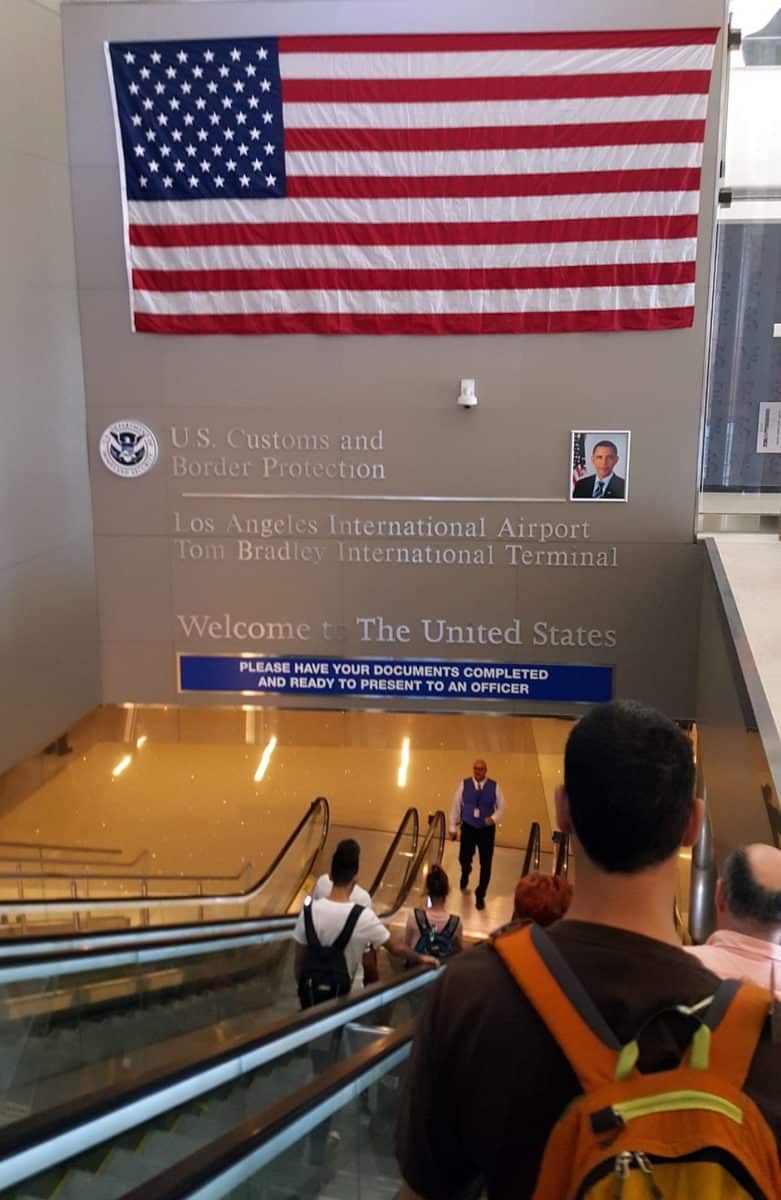
This picture was taken in the summer of 2015 when we entered the US. We arrived on an international flight from Israel, with a connecting flight in Rome.
That nice guy at the bottom of the escalators was welcoming Americans back home and directing everyone to the right lines for border control. There are always separate lines for returning citizens and visitors.
Domestic vs. International Airports
International airports allow you to travel all over the world, as opposed to domestic airports, which generally only allow flights within the same country.
The key difference here is that international airports are set up for border control and customs inspections.
With longer runways - to accommodate larger planes - and larger terminals, international airports are often also much more extensive than their domestic counterparts.
While it’s true that some domestic airports may have “international” in their title, these types of flights are often handled on an irregular (and sometimes very rare) basis and may not suit your schedule.
Domestic airports are built in a manner conducive to more localized travel, and as such, they cannot accommodate consistent international flights.
International airports typically handle both international and domestic flights.
Domestic airports typically only handle domestic flights.
With nearly 20,000 airports in the United States alone, you may feel overwhelmed with the sheer volume to choose from.
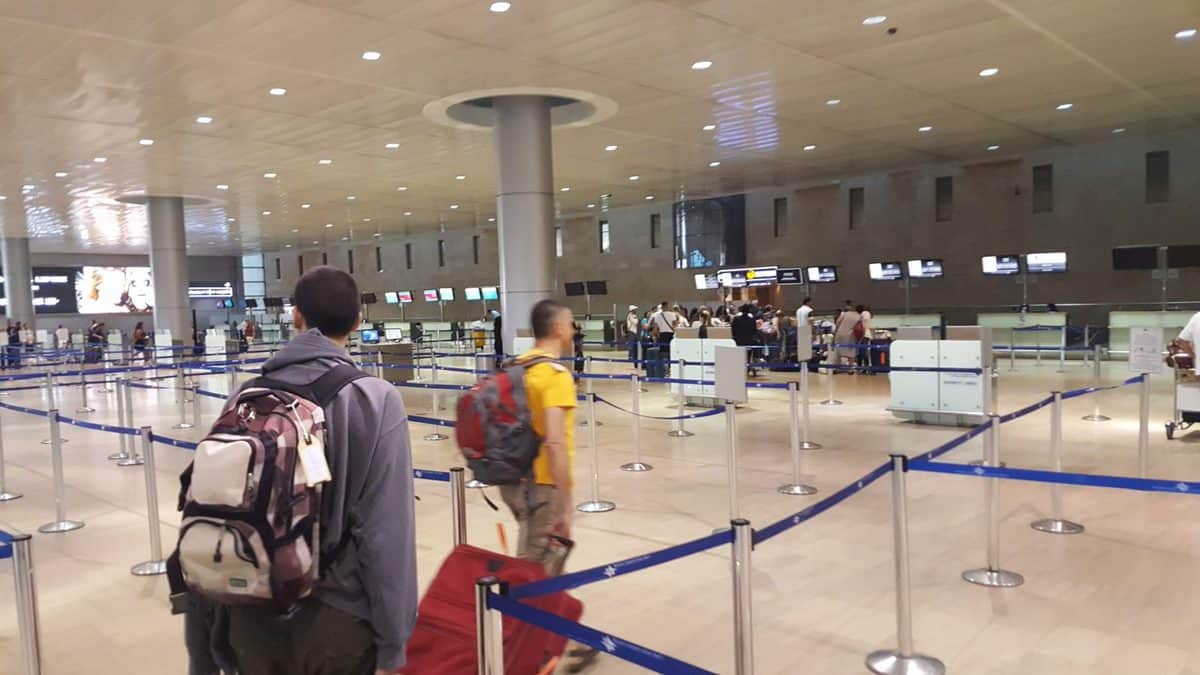
You may still need to use the services of one of those 20,000 if you choose to layover to a larger airport from a smaller, domestic one – and you may want to do this for many reasons – but you will mostly want to focus on international airports starting. You can then plan around the one you’ve chosen if need be.
Consider Passenger Volume
You may also want to consider passenger volume to help in decreasing your wait time and any potential delays.
However, keep in mind that the large airport where passenger volume is consistently high will be better equipped to handle all those people and suitcases.
In other words, it's the unexpected peaks in passenger volume that you should be concerned about.
Airports in the summer of 2022
We're back to traveling, now that covid restrictions have been lifted. That's both good and bad.
Airports are understaffed because most of their personnel were laid off during the early stages of the pandemic.
Airports and airlines simply don't have enough employees to handle all of the passengers and luggage they're seeing.
It's not just in London.
This is a worldwide problem. Over the last two months, both my son and parents were on (different) international flights.
My son was lucky. He only experienced a single 8-hour delay on his way back from London. It was nerve-wracking, as there was no communication from the airline (did I mention understaffed?) but at least he finally made it on that flight back home).
My parents weren't so lucky.
They were flying from Tel Aviv to Chicago. After standing in long lines at the airport, they finally boarded their night flight. They even texted us this picture of my Dad on board the plane!
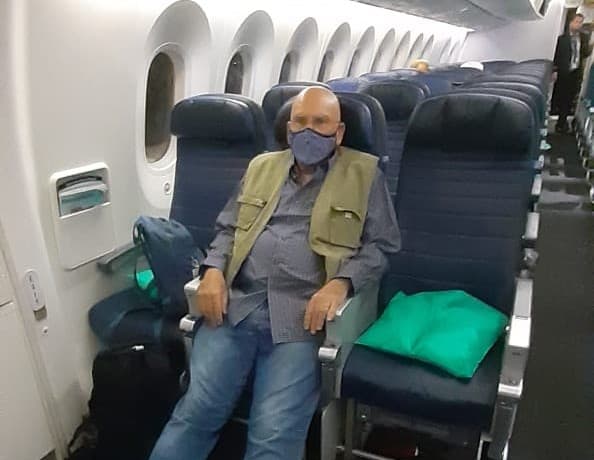
Then an hour later, they texted this picture -
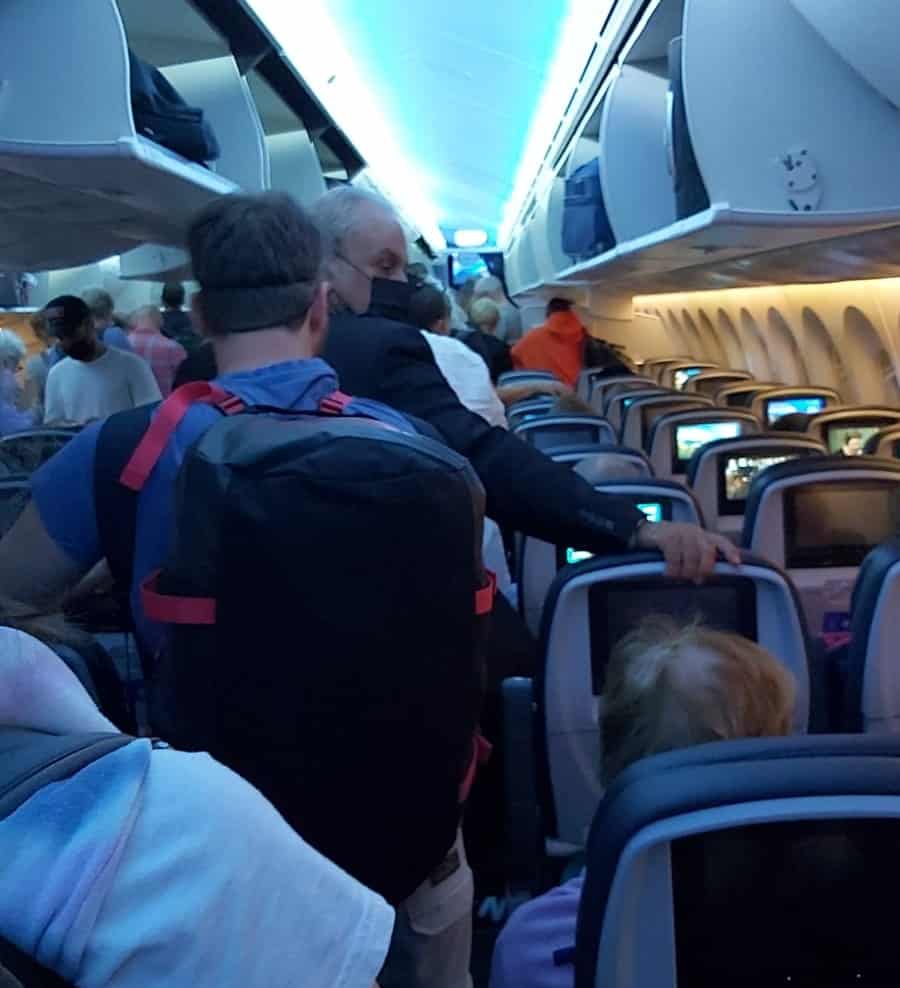
They were asked to de-board the plane because of a minor technical issue. With no airport crew around to fix the issue right away, the flight had to be grounded.
They were told they would leave on the following flight the next day.
Then another email arrived, letting them know this was not happening. So they were moved to yet another flight.
Two days later, the third flight finally took off - only an hour later than planned.
If you're planning any flight in 2022, at the very least, be extremely patient and be prepared for the worse.
But, back to more general information about international vs domestic flights.
Shopping at an International Airport
If you forgot to pack something – or you wish to stop and enjoy what they have to offer – all major airports include stores of many kinds, including gift shops, restaurants, and food courts.
And here's the thing -
International airports typically feature duty-free shops!
That's where luxury items and amenities can be purchased tax-free. By selling mostly to tourists who will be taking these items out of the country, many local and national taxes are waived.
What else is there to do in an international airport?
You will generally find WiFi services available, as well as locations for currency exchange.
Not only will you find the standard fare of shops and eateries, but some international airports also provide areas where passengers can rest and even take a nap.
Those areas are designated for those who may have become stranded or laid over. These days, they are usually reserved for business and first-class passengers.
More often, however, you will find hotels on the premises to allow for comfort and privacy. Anyone can use those - if they're willing to pay for their stay.
Airports are often massive (more on that below), and as such, you may find yourself in need of on-site transportation. Thankfully, you will often find services for just that, such as rail networks, curbside pickup, taxis, shuttle services, and buses.
If you need to leave your personal or rental car at the airport, many have parking garages for your convenience. This is highly beneficial if you don’t want to bother with an airport pickup or taxi service upon arriving home.
International Flights FAQ
Here are some of the questions people often ask about international flights.
Do You Need a Passport to Book an International Flight?
Yes. Any time that you are traveling abroad, a passport is mandatory and required. You must also display your passport to enter the country to which you are traveling.
In some cases, you would also need a visa.
As long as your passport is valid and in good condition, you don't need any additional forms of ID.
Do They Serve Meals on International Flights?
That depends. The answer used to be "absolutely", and meals are still featured on most transatlantic flights.
However, during shorter international flights, for example from one European country to another, they often serve only snacks and beverages.
On a low-cost flight, international or otherwise, you can purchase snacks and drinks but they're not included in the price of your flight ticket (unless you fly business or first-class - in which case, it depends).
The class in which you are traveling plays a significant role in the quality of your meals. We've only traveled in the economy until now. This is what a hot meal looks like when it arrives -
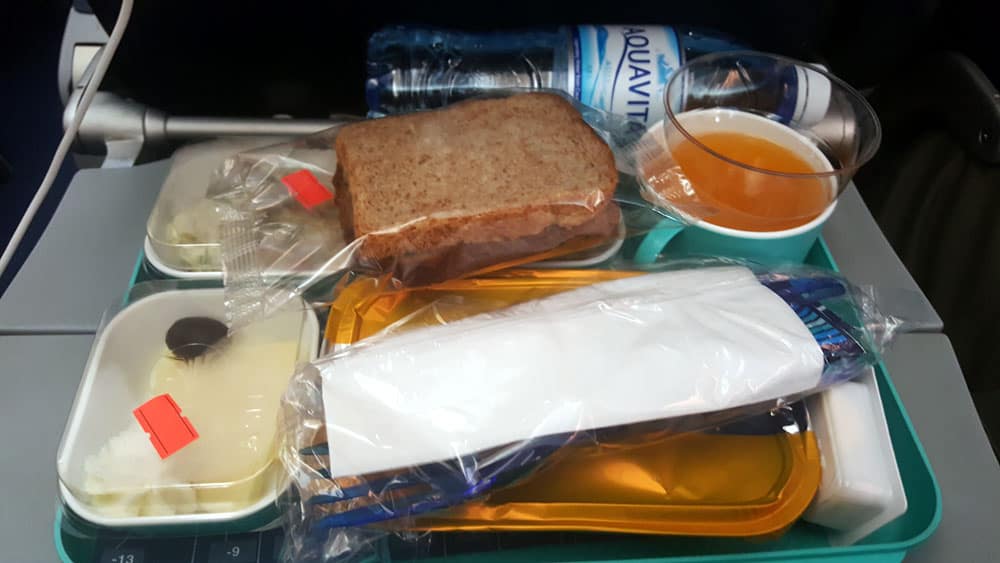
Nothing to write home about, in terms of the culinary experience.
However, I always say it's a welcome distraction on a long flight. Handling everything in such a small space is challenging and in a way, sort of entertaining.
When meals are served, you usually get a choice of vegan, vegetarian, kosher, low-sodium, and diabetic meals.
These all have to be pre-ordered when you book your flight or during the online check-in phase. If you don't tell them in advance, the airline won't have a special meal ready for you. Kids under 12 usually have their own kid's meals.
Do They Provide Blankets on International Flights?
In our experience, you do on transatlantic flights. Since airplanes are often rather chilly forms of transportation, it is generally standard fare to receive a blanket, as well as a pillow for use during the flight.
You're not supposed to keep the blanket though. They take them at the end of each flight and - presumably - wash and sanitize them for the next round of passengers.
If this is a sanitary concern for you, you can always bring your carry-on pillow, provided its size is within acceptable guidelines.
This is what a good-quality typical flight pillow looks like -
Click here to see this pillow on Amazon
Check out our post on where to buy travel accessories for help finding all the comfort items you need for an international flight.
Some airlines really pamper you on transatlantic flights. On our flight to New York with Azerbaijan Airlines, we each received a small blue bag that had earplugs, an eye mask, a small toothbrush and toothpaste, and even a pair of blue socks!
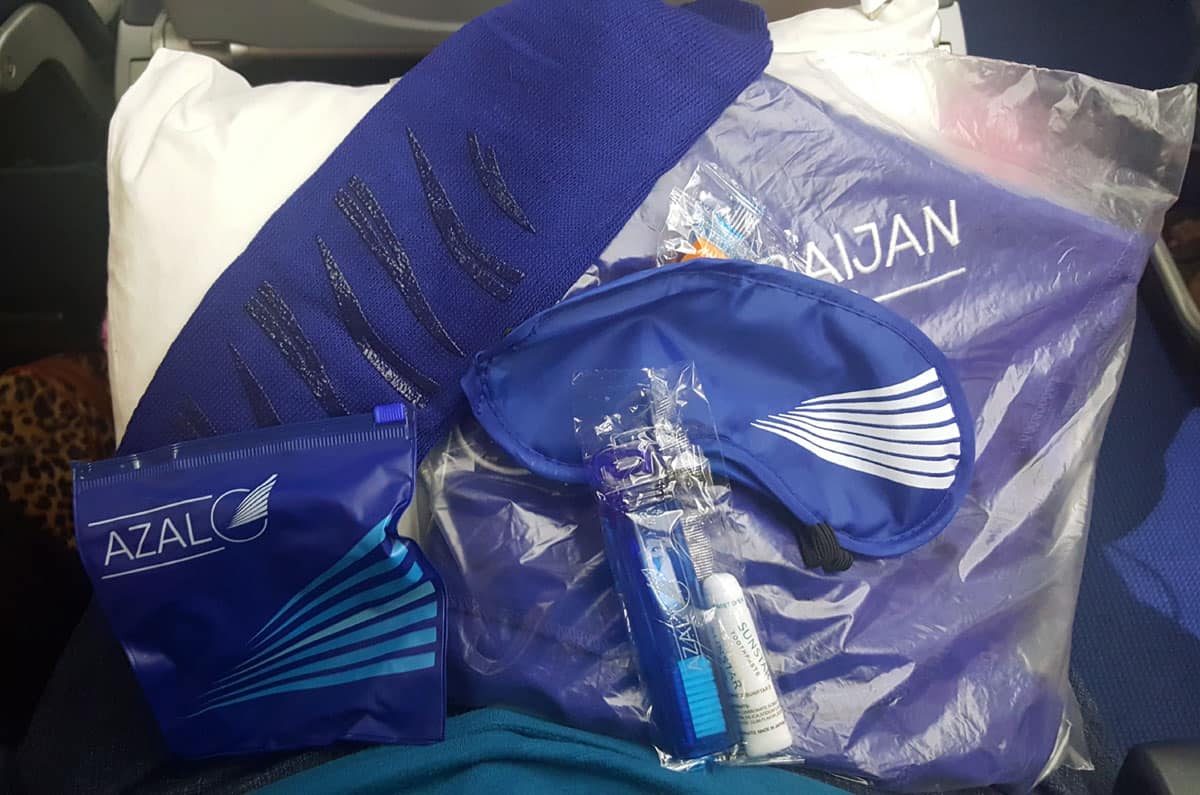
Do You Get WiFi on International Flights?
While WiFi availability is growing rapidly in air travel, it isn’t available on all flights and with all carriers.
You will first need to check with your airline to ensure that they offer it, and then find out if your flight path has it as well. You can do this by looking at the coverage map on your potential airline’s website.
Not only will this service cost you, but it may also be limited in its functionality. Don't assume you'll be able to carry a Zoom call while in the air. You're likely to experience a relatively slow connection, so downloading your videos beforehand is recommended.
What Is a Transatlantic Flight?
As its name implies, transatlantic flights travel across the Atlantic Ocean, connecting passengers to the Americas (North, Central, and South), as well as the Middle East, Africa, and Europe.
Depending on weather conditions, transatlantic routes – called North Atlantic Tracks (NATs) – change daily to compensate for any issues that weather may cause for aircraft.
For passenger convenience, eastbound flights are usually in operation during the night, while ones westbound operate during the day. Approximately 2,500 aircraft make transatlantic flights daily.
Transatlantic Flight Times
As mentioned above, the night-time hours of an eastbound flight will generally make landfall between 6:00 AM to 9:00 AM UTC. Conversely, daytime westbound flights will usually make landfall between the hours of 12:00 PM to 3:00 PM UTC. It can certainly vary though, so carefully check your tickets.
Transatlantic flights are obnoxiously long too.
To be honest, I dread these flights. But, as long as you're prepared, they are eventually over.
My tip: Stay hydrated. Yes, this means more bathroom trips, but getting up and walking around every hour or two is a good thing.
Should I Lock My Luggage When Flying Internationally?
For your peace of mind, you can lock your checked luggage when flying to any destination, provided you use a TSA-approved lock.
See this TSA-Approved lock on Amazon
TSA agents carry master keys that will unlock all approved luggage locks if they feel your luggage requires extra screening.
And don't assume that your carry-on luggage will be with you at all times. The last people boarding the plane may be asked to send their carry-ons in the cargo hold. So, you may want to lock those smaller items as well, or at least have a lock on them.
By the way, a TSA-approved lock does not guarantee anything once you're outside the US.
When flying internationally, once you make landfall outside of the United States, local agents won't have those TSA master keys.
If they feel the need to look inside your luggage, you may run the risk of having your lock cut off for them to complete their inspection.
That's why we prefer to keep our suitcases unlocked on international flights.
Tips for Making International Travel Easier
Here are a few quick tips that could help you when traveling internationally.
1. Passports and visas
Lastly, and this is a big one, find out ahead of time if the country in which you are traveling has any entrance and exit fees.
That’s right; some won’t allow you to do either without paying a fee.
If that is the case, make sure that you have cash set aside for such a situation, or an international credit card open for international transactions.
2. Make copies of your passport
Take clear photos of your passport's main page. Keep them accessible on the cloud and also carry a printed copy with you.
Leaving a copy with someone back home is always a good idea too (a digital copy should be enough).
3. Carry some local money (and/or a credit card)
Talk to your credit card company to make sure your card will work overseas while traveling. If traveling to Europe, you may need to upgrade to a card with the new chip technology. We usually prefer to carry some cash for the first days on us, just in case.
4. Vaccinations
Most western countries don't require any vaccinations except for covid shots. Yes, one more thing to check these days.
And consider yourself lucky because when flying in 2021, you had to produce proof of vaccination and also a negative covid test. If you could travel at all, that is.
As for other vaccines.
You don’t want to go through all the steps of planning for a trip only to find out at the last minute that you don’t have proper vaccinations. Check with your doctor well in advance to ensure that you’re up-to-date.
5. Carry your valuables and medications on you
Don't send your medications in your suitcase. Have at least a week's supply in the bag that you're carrying with you. The same goes for any valuables. Luggage can and does get lost.
We also carry a change of underwear and one set of clothes for each person in the trolley that we take on board the plane. Meds and everything that is absolutely necessary for the flight itself stays in our handbags or even pockets.
And again, some airlines may ask you to send your trollies too, right at the gate, so it's best to be prepared.
All of the above is especially true in 2022 - when your chances of losing luggage are higher than ever.
6. Get some food and an empty bottle for the flight
Even if food is served, I like to have some snacks with us. Just in case the boys don't like the food served, or that someone gets hungry in between meals.
Energy bars are a good alternative, as they're small and filling.
You can't carry a full bottle of water through security, so we buy one after passing the check and while waiting at the gate. During the flight, I get up and fill it up to keep hydrated.
7. Get up often during the flight
It's very tempting to just cocoon up during a long flight, avoiding drinking and bathroom visits. That's a huge mistake, especially for adult travelers.
It's very important to stay hydrated and move around to prevent blood clots from forming.
8. Lip balm and hand cream can come in handy
Airplane air is dry, so if you're prone to chapped lips and dry skin, get some with you in advance. Find small travel-size products. Any large tubes (larger than 100CC) will be taken away from you during the security checks.
What Are Some International Airports?
I've been asked for examples of international vs domestic airports. So, let's wrap up with some airport-name-dropping.
Here are some major international airports in the USA.
Detroit Metropolitan Airport
The Detroit Metropolitan Airport, or DTW, is one of the major international airports in the United States. Located in Romulus, Michigan, the DTW covers a massive 4,850 acres, with four runways totaling nearly 11 miles.
It averages over 35 million passengers every year, offering flights to 30 international destinations with 39 of the United States covered, as well. Not only the DTW Michigan’s busiest airport, but it also has one of the largest airline hubs in the country.
Minneapolis-Saint Paul International Airport
The Minneapolis-Saint Paul International Airport, or MSP, serves both the public and military for international flights. The MSP is located in Hennepin County, Minnesota, juxtaposed within 10 miles of both downtown Minneapolis and St. Paul.
Covering 2,930 acres, it’s a little over half the size of the DTW, with approximately seven miles of total runway. Averaging nearly 38 million passengers annually, the MSP ranks fairly high in terms of busiest airports.
Las Vegas McCarran International Airport
The Las Vegas McCarran International Airport, or LAS, is another large international airport. Located in Paradise, Nevada, it covers 2,800 acres and has four runways that span over eight miles combined.
With nonstop flights to cities in Europe, Asia, and the United States, it serves almost 50 million passengers every year.
Dallas/Fort Worth International Airport
The fourth busiest airport in the world (aircraft movement) and 15th busiest in passenger traffic, the Dallas/Fort Worth International Airport, or DFW, is located on the Dallas and Tarrant county line in Texas.
Clocking in at over 17,000 acres, it is the second-largest airport in the United States, so large that it has its own post office, medical emergency, police, and fire rescue. It serves more passengers annually than any other entry listed here – nearly 70 million.
Orlando International Airport
Located just six miles from downtown Orlando, the Orlando International Airport, or MCO, is the busiest airport in Florida. Open for public use, the MCO serves approximately 47 million passengers annually.
It covers over 13,000 acres, making this airport one of the largest in the United States, with four runways totaling nearly 10 miles in length.
What Are Some Domestic Airports?
Here are some popular domestic airports in the USA.
Dallas Love Field
The Dallas Love Field (DAL) airport was once Dallas, Texas’ main airport of use until the massive Dallas/Fort Worth International Airport opened in 1974. Located just six miles from Dallas, it sports roughly three miles of runways while serving approximately 16 million passengers annually.
Savannah/Hilton Head International Airport
A commercial and military airport, the Savannah/Hilton Head International Airport (or SAV) is located in Savannah, Georgia. With two runways that total just over three miles, it serves approximately 3 million passengers annually, with that number increasing every year.
The Savannah Air National Guard is located at the airport, serving to transport its personnel, as well.
John Wayne Airport
Serving Orange County, California, as well as the Greater Los Angeles area, the John Wayne Airport (SNA) serves over 10 million passengers every year. Smaller than others listed here, its two runways equal around 1.5 miles in total length.
The SNA is just 14 miles from the Disneyland Resort, while the famous LAX is 35 miles away.
Manchester-Boston Regional Airport
The Manchester-Boston Regional Airport (MHT) is another public airport located 3 miles from Manchester, New Hampshire. Its two runways total just over three miles in length.
The MHT generally serves around 1.5 million passengers annually and is New England’s fifth-largest airport in terms of passenger volume.
Palm Beach International Airport
The Palm Beach International Airport, or PBI, is located in Palm Beach County, Florida and has three runways that total just over three miles. It serves approximately 6.5 million passengers every year, with limited international flights.
These include seasonal routes to Montreal, and Toronto, Canada, as well as year-round access to the Bahamas.
Final words
Flying can be a fun experience, though the longer it gets, the more tedious it tends to get. Still, you can't do without it if you want to travel abroad. I hope you found this guide helpful. If you have more tips, insights or questions, don't hesitate to leave me a comment. And you may also want to check out this guide -
Flying with a teenager - what to bring on the plane


